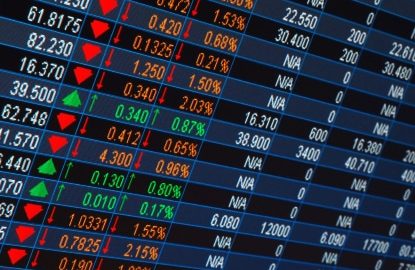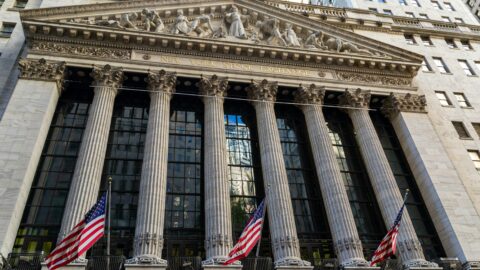US stock exchanges: increasing volatility
After a good start to the US reporting season, the tide on the US stock exchanges turned last week. Disappointing figures from the technology sector overshadowed the good results from major US banks, obliterating the Dow Jones’ profits for the year and even dipping it into the red. The technology index Nasdaq Composite, on the other hand, still shows positive year-to-date figures, but has lost around 850 points in October alone, which could mean the weakest October since 2008. A brief surge on Thursday failed to recover the losses.
Towards the end of the week, the weak results of Amazon and Google’s parent Alphabet had a particularly strong impact. Despite billion-dollar profits, both companies disappointed the very high market expectations. The quarterly revenues of both companies failed to meet projections, and analysts and investors appeared to be disappointed in their growth rates. A few days prior, the results of IBM had disappointed investors with declines in both sales and profits, while positive figures from Intel and Facebook weren’t sufficient to mitigate the pessimistic sentiment.
Investors are already looking ahead to 2019
However, corporate figures are not the only reason for the current volatility in sentiment. According to experts, investors are already looking ahead to 2019 – where the outlook for corporate profits has recently become a little more grim as a result of macroeconomic developments. Ongoing trade wars, more volatile oil prices due to political tensions between the US and Saudi Arabia, the budget dispute between the EU and Italy, and the faltering Brexit negotiations are fueling increasing concerns about the state of the global economy.
The latest US economic report, the so-called “Beige Book”, published by the Federal Reserve was rather restrained and saw robust but less dynamic growth for the US economy. At 3.5 per cent, annualised growth in Q3 was significantly weaker than in the previous quarter (Q2 2018: 4.3 per cent), but managed to just exceed expectations.
According to the Fed, the US economy chiefly suffers from uncertainty about further trade policy developments. The US is currently in dispute with China about its trade policy. However, the conflict is also taking its toll on the People’s Republic, with 6.5 per cent in Q3 of 2018 year over year marking the weakest growth since 2009.
The situation on the stock markets is exacerbated further by rising key interest rates in the US. The central bank raised its key interest rate corridor to 2.00–2.25 per cent, indicating four further hikes until the end of 2019. Some central bankers have even spoken out in favour of one more hike in 2018. As a result of higher interest rates, US bond yields have also risen significantly again. The higher interest rate on the bond market tends to make investments in equities less attractive and recently put a strain on the stock markets.
Disclaimer:
Forecasts are not a reliable indicator for future developments.
Legal disclaimer
This document is an advertisement. Unless indicated otherwise, source: Erste Asset Management GmbH. The language of communication of the sales offices is German and the languages of communication of the Management Company also include English.
The prospectus for UCITS funds (including any amendments) is prepared and published in accordance with the provisions of the InvFG 2011 as amended. Information for Investors pursuant to § 21 AIFMG is prepared for the alternative investment funds (AIF) administered by Erste Asset Management GmbH pursuant to the provisions of the AIFMG in conjunction with the InvFG 2011.
The currently valid versions of the prospectus, the Information for Investors pursuant to § 21 AIFMG, and the key information document can be found on the website www.erste-am.com under “Mandatory publications” and can be obtained free of charge by interested investors at the offices of the Management Company and at the offices of the depositary bank. The exact date of the most recent publication of the prospectus, the languages in which the fund prospectus or the Information for Investors pursuant to Art 21 AIFMG and the key information document are available, and any other locations where the documents can be obtained are indicated on the website www.erste-am.com. A summary of the investor rights is available in German and English on the website www.erste-am.com/investor-rights and can also be obtained from the Management Company.
The Management Company can decide to suspend the provisions it has taken for the sale of unit certificates in other countries in accordance with the regulatory requirements.
Note: You are about to purchase a product that may be difficult to understand. We recommend that you read the indicated fund documents before making an investment decision. In addition to the locations listed above, you can obtain these documents free of charge at the offices of the referring Sparkassen bank and the offices of Erste Bank der oesterreichischen Sparkassen AG. You can also access these documents electronically at www.erste-am.com.
Our analyses and conclusions are general in nature and do not take into account the individual characteristics of our investors in terms of earnings, taxation, experience and knowledge, investment objective, financial position, capacity for loss, and risk tolerance. Past performance is not a reliable indicator of the future performance of a fund.
Please note: Investments in securities entail risks in addition to the opportunities presented here. The value of units and their earnings can rise and fall. Changes in exchange rates can also have a positive or negative effect on the value of an investment. For this reason, you may receive less than your originally invested amount when you redeem your units. Persons who are interested in purchasing units in investment funds are advised to read the current fund prospectus(es) and the Information for Investors pursuant to § 21 AIFMG, especially the risk notices they contain, before making an investment decision. If the fund currency is different than the investor’s home currency, changes in the relevant exchange rate can positively or negatively influence the value of the investment and the amount of the costs associated with the fund in the home currency.
We are not permitted to directly or indirectly offer, sell, transfer, or deliver this financial product to natural or legal persons whose place of residence or domicile is located in a country where this is legally prohibited. In this case, we may not provide any product information, either.
Please consult the corresponding information in the fund prospectus and the Information for Investors pursuant to § 21 AIFMG for restrictions on the sale of the fund to American or Russian citizens.
It is expressly noted that this communication does not provide any investment recommendations, but only expresses our current market assessment. Thus, this communication is not a substitute for investment advice.
This document does not represent a sales activity of the Management Company and therefore may not be construed as an offer for the purchase or sale of financial or investment instruments.
Erste Asset Management GmbH is affiliated with the Erste Bank and austrian Sparkassen banks.
Please also read the “Information about us and our securities services” published by your bank.




